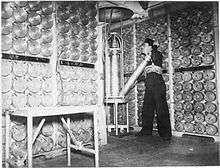HMS Vanity (D28)
 HMS Vanity in October 1941. | |
| History | |
|---|---|
| Class and type: | Admiralty V-class destroyer |
| Name: | HMS Vanity |
| Ordered: | 30 June 1916[1] |
| Builder: | William Beardmore and Company, Dalmuir, Scotland[2] |
| Laid down: | 28 July 1917[2] |
| Launched: | 3 May 1918[2] |
| Commissioned: | 21 June 1918[1] |
| Decommissioned: | 1930s[2] |
| Identification: |
|
| Recommissioned: | August 1939[2] |
| Decommissioned: | 1945[2] |
| Motto: | Vanitas vanitatum ("Vanity of Vanities")[2] |
| Honours and awards: | |
| Fate: | |
| Badge: | A gold, blue, and green peacock's feather on a black field[2] |
| General characteristics | |
| Class and type: | Admiralty V-class destroyer |
| Displacement: | 1,272-1,339 tons |
| Length: | 300 ft (91.4 m) o/a, 312 ft (95.1 m) p/p |
| Beam: | 26 ft 9 in (8.2 m) |
| Draught: | 9 ft (2.7 m) standard, 11 ft 3 in (3.4 m) deep |
| Propulsion: |
|
| Speed: | 34 kt |
| Range: | 320-370 tons oil, 3,500 nmi at 15 kt, 900 nmi at 32 kt |
| Complement: | 110 |
| Armament: |
|
The second HMS Vanity (D28, later L38) was a V-class destroyer of the British Royal Navy that saw service in World War I and World War II.
Construction and commissioning
Vanity was ordered on 30 June 1916 as part of the 9th Order of the 1916-17 Naval Programme. She was laid down on 28 July 1917 by William Beardmore and Company at Dalmuir, Scotland, and launched on 3 May 1918. She was commissioned on 21 June 1918.[1][2]
Service history
World War I and interwar years
Vanity saw service in the last months of World War I, which ended with the armistice with Germany on 11 November 1918. She took part in the Baltic campaigns of the allied intervention in the Russian civil war. Vanity remained in service until the 1930s, when she was decommissioned and placed in reserve.[2]
Vanity was recommissioned in August 1939 for the Royal Review of the Reserve Fleet by King George VI.[2]
World War II


After the United Kingdom entered World War II in September 1939, Vanity was assigned to the 15th Destroyer Flotilla at Rosyth, Scotland, for convoy escort and patrol duties in the North Sea. Later in the month she was selected for conversion into an antiaircraft escort, and underwent conversion from October 1939 to June 1940. In July 1940 she underwent post-conversion acceptance trials, and was accepted for service on 12 August 1940, when her pennant number was changed from D29 to L38. She then returned to convoy escort duty in the North Sea. In December 1941, she was "adopted' by the village of Winteringham (Lincolnshire), in a Warship Week National Savings campaign.[1][2]
Vanity interrupted her regular duties in January 1942 to take part in Operation Performance, steaming to Scapa Flow in the Orkney Islands to deploy with the Home Fleet to cover the break-out of merchant ships from Sweden into the North Sea via the Danish Straits.[2][3] In February 1942, she returned to her convoy escort and patrol duties in the North Sea, which she carried out until February 1945. She did not take part in operations related to the Allied invasion of Normandy in the summer of 1944.[2]
In February 1945, Vanity was reassigned to convoy escort and patrol duty in the English Channel, where North Atlantic convoys had been rerouted after the threat of German air attacks from France had abated, to reinforce convoy defences in the face of increased activity by German snorkel-equipped submarines in the area. She continued these operations until the surrender of Germany in early May 1945.[2]
Decommissioning and disposal
Vanity was decommissioned soon after Germany's surrender – she no longer was carried on the Royal Navy's active list as of July 1945 – and was placed in reserve. Placed on the disposal list in 1946, she was sold on 4 March 1947 for scrapping at Grangemouth, Scotland.[1][2]
Notes
Bibliography
- Campbell, John (1985). Naval Weapons of World War II. Annapolis, Maryland: Naval Institute Press. ISBN 0-87021-459-4.
- Chesneau, Roger, ed. (1980). Conway's All the World's Fighting Ships 1922–1946. Greenwich, UK: Conway Maritime Press. ISBN 0-85177-146-7.
- Colledge, J. J.; Warlow, Ben (2006) [1969]. Ships of the Royal Navy: The Complete Record of all Fighting Ships of the Royal Navy (Rev. ed.). London: Chatham Publishing. ISBN 978-1-86176-281-8. OCLC 67375475.
- Cocker, Maurice; Allan, Ian. Destroyers of the Royal Navy, 1893-1981. ISBN 0-7110-1075-7.
- Friedman, Norman (2009). British Destroyers From Earliest Days to the Second World War. Annapolis, Maryland: Naval Institute Press. ISBN 978-1-59114-081-8.
- Gardiner, Robert & Gray, Randal, eds. (1984). Conway's All the World's Fighting Ships: 1906–1921. Annapolis, Maryland: Naval Institute Press. ISBN 0-85177-245-5.
- Lenton, H. T. (1998). British & Empire Warships of the Second World War. Annapolis, Maryland: Naval Institute Press. ISBN 1-55750-048-7.
- March, Edgar J. (1966). British Destroyers: A History of Development, 1892-1953; Drawn by Admiralty Permission From Official Records & Returns, Ships' Covers & Building Plans. London: Seeley Service. OCLC 164893555.
- Preston, Antony (1971). 'V & W' Class Destroyers 1917-1945. London: Macdonald. OCLC 464542895.
- Raven, Alan & Roberts, John (1979). 'V' and 'W' Class Destroyers. Man o'War. 2. London: Arms & Armour. ISBN 0-85368-233-X.
- Rohwer, Jürgen (2005). Chronology of the War at Sea 1939-1945: The Naval History of World War Two (Third Revised ed.). Annapolis, Maryland: Naval Institute Press. ISBN 1-59114-119-2.
- Whinney, Bob (2000). The U-boat Peril: A Fight for Survival. Cassell. ISBN 0-304-35132-6.
- Whitley, M. J. (1988). Destroyers of World War 2. Annapolis, Maryland: Naval Institute Press. ISBN 0-87021-326-1.
- Winser, John de D. (1999). B.E.F. Ships Before, At and After Dunkirk. Gravesend, Kent: World Ship Society. ISBN 0-905617-91-6.
External links
| Wikimedia Commons has media related to HMS Vanity (D28). |